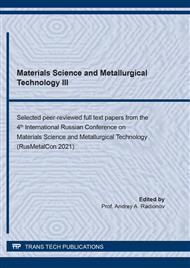[1]
M. Furukawa, Z. Horita, M. Nemoto, T.G. Langdon, The use of severe plastic deformation for microstructural control, Materials Science and Engineering A. 324 (2002) 82-89.
DOI: 10.1016/s0921-5093(01)01288-6
Google Scholar
[2]
E.G. Pashinskaya, Physical and mechanical bases of structure grinding under combined plastic deformation, Weber, Donetsk, (2009).
Google Scholar
[3]
R.Z. Valiev, I.V. Alexandrov, Bulk nanostructured metal materials, Akademkniga, Moscow, (2007).
Google Scholar
[4]
R.Z. Valiev, R.K. Islamgaliev, I.V. Alexandrov, Bulk nanostructured materials from severe plastic deformation, Progress in Materials Science. 45 (2000) 103-189.
DOI: 10.1016/s0079-6425(99)00007-9
Google Scholar
[5]
S. Lezhnev, A. Naizabekov, I. Volokitina, Features of change of the structure and mechanical properties of steel at ECAP depending on the initial state, Journal of Chemical Technology and Metallurgy. 52 (2017) 626-635.
Google Scholar
[6]
G.I. Raab, Development of the Method of Equal-Channel Angular Pressing for Obtaining Ultrafine-Grained Materials: Thesis's Abstract ... Cand. Tech. Sciences: 05.16.05, Ufa, (2009).
Google Scholar
[7]
G.I. Raab, Development of methods of intensive plastic deformation for obtaining bulk ultrafine-grained materials, Bulletin of UGATU. 3 (2004) 67-86.
Google Scholar
[8]
G.I. Raab, G.V. Kulyasov, V.A. Polozovsky, R.Z. Valiev, RU Patent 2,181,314 (2002).
Google Scholar
[9]
A.B. Naizabekov, Zh.A. Ashkeev, S.N. Lezhnev, A.R. Toleuova, Investigation of the process of deformation of billets in an equal-channel step matrix, Izv. Vuzov. Ferrous Metallurgy. 2 (2005) 16-18.
Google Scholar
[10]
S.N. Lezhnev, A.S. Arbuz, I.E. Volokitina, G.A. Gaidarenko, Investigation of the process of aluminum alloy deformation in an equal-channel angular matrix with a channel junction angle of 45°, Metal Processing by Pressure. 1 (2019) 104-109.
Google Scholar
[11]
A. Rosochowski, EU Patent 1,861,211 (2007).
Google Scholar
[12]
L. Olejnik, A. Rosochowski, Methods of fabricating metals for nano-technology, Bulletin of the Polish Academy of Sciences - Technical Sciences. 53 (2005) 413-423.
Google Scholar
[13]
V.Z. Spusganyuk, T.E. Konstantinova, A.A. Davidenko, I.M. Kovalenko, T.A. Zakoretskaya, L.F. Sennikova, N.N. Belousov, L.V. Loladze, A.V. Zavdoveev, Equal channel angular hydroextrusion – an effective method for forming the submicrostructural state of materials, Metal Processing by Pressure. 2 (2007) 37-42.
Google Scholar
[14]
V.Z. Spuskanyuk, A.B. Dugadko, I.M. Kovalenko, N.I. Matrosov, A.V. Spuskanyuk, B.A. Shevchenko, Features of equal-channel multi-angle extrusion, High-Pressure Physics and Technology. 13 (2003) 85-96.
Google Scholar
[15]
Zh.A. Ashkeev, A.B. Naizabekov, S.N. Lezhnev, A.R. Toleuova, Billet deformation in uniform-channel stepped die, Steel in Translation. 35 (2005) 37-39.
Google Scholar
[16]
F.Z. Utyashev, G.I. Raab, Deformation methods for obtaining and processing ultrafine-grained and nanostructured materials, Gilem, Ufa, (2013).
Google Scholar
[17]
A.P. Zhilyaev, T.G. Langdon, Using high-pressure torsion for metal processing: Fundamentals and applications, Progress in Materials Science. 53 (2008) 893-979.
DOI: 10.1016/j.pmatsci.2008.03.002
Google Scholar
[18]
C. Xu, Z. Horita, T.G. Langdon, The evolution of homogeneity in processing by high-pressure torsion, Acta Materialia. 55 (2007) 203-212.
DOI: 10.1016/j.actamat.2006.07.029
Google Scholar
[19]
O.L. Khasanov, E.S. Dilis, Z.G. Bikbaeva, Methods of compaction and consolidation of nanostructured materials and devices, Publishing house of Tomsk Polytechnic University, Tomsk, (2008).
Google Scholar
[20]
S. Erbel, Mechanical properties and structure of extremely strain-hardened copper, Metals Technology. 6 (1979) 482-486.
DOI: 10.1179/030716979803276363
Google Scholar


